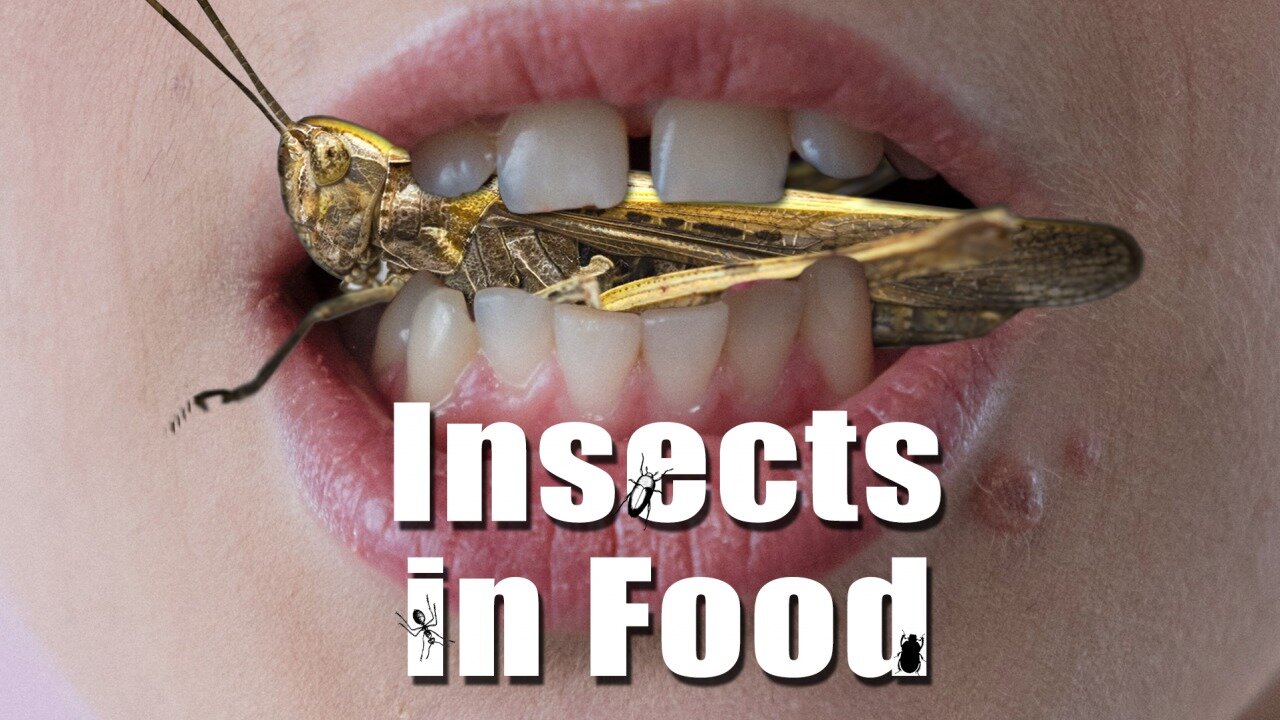Premium Only Content

Disgusting – The 'Insects in Food' File
“You are what you eat” is a frequently quoted piece of wisdom. So it is not surprising that a large number of scandals have startled consumers in recent years. From pesticides and other toxic residues in food to horse meat in lasagna right up to mad cow disease (BSE= Bovine spongiform encephalopathy). Is there now another one coming with the approved officially insects in food? The following documentary shows the frightening risks and financial interests in this insect business.
In January 2023, the EU approved the addition of insects in food, with the house cricket and the larvae of the grain mold beetle, also known as buffalo worms. This led to an outcry from many concerned consumers on social media. Mealworms and migratory locusts have already been allowed in various forms of processing in a variety of foods since 2021, including bread, cereals, soups, pasta, snacks, chocolate, etc. The mainstream media are trying – again, of course, with reference to experts – to make these creepy-crawlies, which are rather disgusting for Europeans, palatable to us. As is so often the case, climate protection and the alleged food security of a growing world population are used as arguments. Interestingly enough, this is the same media that a few years ago was warning us urgently about the risks of insects in food. A sudden change of mind, reminiscent of the 180 degree turn of the media regarding Corona. In January 2020, those who considered Corona dangerous were still defamed, from February onwards, all those who considered it to be just a flu. Reason enough to take a closer look at what is behind this current “insect hype” and which possible motives are not mentioned to the public.
1. The EU Regulations
As you would expect, there is also an EU regulation for insect admixtures. This specifies which insect ingredients may be used, how they may be processed, and in what quantities and for what purposes. The EU also refers to the information and studies provided by the manufacturer, which of course are subject to the property rights and data protection of the manufacturer. This reminds one again of the approval of the Corona vaccines. According to these EU regulations, cereal bars, for example, may contain 25% and whey powder 35% of cereal mold beetle larvae powder. Meat analogs, which most consumers assume are not of animal origin, may even contain up to 40% cereal mold beetle paste and up to 80% frozen migratory locust. If the consumer does not want to fall for this deceptive packaging, there is nothing left to do but to meticulously read the list of ingredients for each product. If one of the following terms appears there, insect ingredients are included:
“Locusta migratoria” (migratory locust).
“Acheta domesticus” (domestic cricket)
“Tenebrio molitor” (flour beetle)
“Alphitobius diaperinus” (grain mold beetle).
The colorant carmine (E120), which is obtained from dried female scale insects, and the coating agent shellac (E904) have been common in our foods for some time and are frequently found in the lists of ingredients. This comes from the excretions of lacquer scale insects, which were also used in the past to make gramophone records.
Other insects for admixture in the diet are planned but are currently still in the approval process, such as the male honey bee larva and the black soldier fly larva.
2. Labeling Fraud on the Benefits
Insects, for example, are touted in the health section of the German 'Tagesschau' daily news, with reference to the Food and Agriculture Organization (FAO), as “a highly nutritious and healthy food source with a high content of protein, vitamins, unsaturated fatty acids, fiber and minerals.” In addition, the overview table of the 'Tagesschau' on Instagram shows significantly higher nutritional values of crickets compared to those of pork, beef and chicken.
With a small flaw – there the values of freeze-dried crickets were compared with meat. If you look directly at the FAO, the ratio looks quite different. There, crickets are also given in the correct comparison value as fresh weight with only 8 to max. 25 g of protein per 100 g. So only one eighth to max. one third of that with which the daily news wanted to suggest the advantage over meat.
Insect products in European households solve neither the food crisis in Africa nor the problems of our factory farming. Such statements are more likely to correspond to the wishful thinking of ideologues or the pen of marketing strategists. Africans cannot afford European insect products and the share of African agricultural products for the European feed industry is negligible. This will not relieve the food situation in Africa. On the contrary, it is to be feared that through the increased consumption of insect protein in the EU, the resulting surplus meat products will be additionally exported to Africa. This will put even more pressure on the small farmers there and further worsen their economic situation.
Moreover, the insects are not captured in nature but bred in special farms. A 16,000-square-meter insect facility is currently being built in France for the black soldier fly, which has previously only been permitted as animal feed. This insect factory, which will be more than two soccer fields in size, will be fed with up to 70,000 metric tons of organic waste per year. This is pure factory farming, with all the corresponding problems and risks. And without any regulations or requirements, since the European Animal Welfare Directive (98/58/EC) does not apply to the keeping of invertebrates.
Also, the claimed by the “Süddeutsche Zeitung” that the voracious appetite of the larvae can be useful for humans in waste disposal when the maggots gorge themselves on manure, dung or vegetable residues is as unappetizing as it is false. In the EU, farmed insects are considered livestock and thus also the corresponding feed regulations, according to which animal by-products may not be fed. The reason for this is the earlier crises in connection with feed, as with mad cow disease (BSE). No one should get false hopes. Many insects are bred in Asia under the hygiene standards that are common there.
And in the EU there are voices calling for a change in the feed regulation so that the insects can also be fed catering waste, fecal matter and sewage sludge. Or perhaps also old polystyrene to be disposed of, which mealworms eat. As is so often the case, the later consequences for the consumer are unclear.
3. Health Risks
Due to the almost uncontrollable hygienic conditions during husbandry, there is a risk of pathogens or parasites being transmitted to humans. From mealworms, for example, Hymenolepis nana and Hymenolepis diminuta, two species of dwarf tapeworms, are known. Recent studies show that some bacteria in insects consumed in Thailand are pathogenic to humans, such as Vibrio, Staphylococcus, and Clostridium. And not only in the raw state but also in processed insect products.
The abundant chitin in insect carapaces can also trigger allergies. For people who are allergic to crustaceans, house dust mites or mollusks, there are particular risks due to so-called cross-allergies. The symptoms range from itching to allergic shock and can also lead to death. In 18% of the people who died of anaphylactic shock in China, insects as food were the cause.
Furthermore, chitin can lead to immunological and inflammatory reactions and is associated with the development of chronic diseases and Alzheimer’s disease. This is confirmed by the elevated chitin levels found in Alzheimer’s patients.
The very fat-rich insect larvae are also an ideal storehouse of pollutants. Both for residues of sprays such as pesticides and fungicides, as well as environmental toxins and heavy metals. Depending on the type of insect, studies have detected greater or lesser amounts of cadmium, lead, mercury and arsenic.
At the latest when animal waste is fed to the insects, there is another risk when they are eaten: prions. These are abnormal proteins that can cause diseases such as bovine spongiform encephalopathy (BSE) in cattle and Creutzfeldt-Jakob disease in humans and became known through the mad cow scandal. After the experiences with the, according to experts, supposedly side-effect-free Corona vaccinations, it should reassure few of the well-informed people that researchers currently assume that insects are not capable of forming prions. They do not know for sure – and certainly not what the risks are for the end consumer.
One cannot help but think that politicians are once again putting the health of the public at risk, and are well aware of it, as one of the paragraphs in the cereal mold beetle approval suggests: “Food supplements” containing larvae of Alphitobius diaperinus in powder form should not be consumed by persons under 18 years of age, and therefore a labeling requirement should be provided to properly inform consumers about this.
4. Follow the Money
One company has been given exclusive rights to supply the insects for five years at a time. Where is the otherwise so much touted free market and competition? It is conspicuous that the insect companies were mostly founded only a few years ago, but investors have already invested several hundred million euros in them. Alone, Ynsect, the company founded in 2011 that has now received approval for the cereal mold beetle, has so far received about $450 million from investment funds, banks and public institutions. These investors, of course, want to see a return on that investment. The soon-to-be-operational insect farm in Amiens, France, is expected to produce up to 200,000 metric tons of insect protein for food and feed per year, generating revenues of about EUR 1 billion.
No one would invest in such start-up companies if the necessary approvals are questionable and the products – at least in Europe – are predominantly met with rejection. Unless someone has influence on political decisions and the necessary financial means to influence consumer behavior accordingly.
5. Great Reset in Food Supply
Lockdowns, closed shops and the collapsed logistics chains during Corona have noticeably shown how fragile a globalized and centralized supply is. Especially in the food sector, regional supply offers the greatest possible security, which also makes ecological sense due to short distances.
The goals of the WEF and its strategic partners are presented to us as ecological, but they envisage exactly the opposite. For the reset of food and agriculture, they favor projects with genetically modified organisms, proteins produced in the laboratory, as well as the ever stronger linking of drugs, chemicals and food, which inevitably leads to significantly greater control and dependence on the multinational corporations involved. In association with major foundations, such as the Wellcome Trust, the Rockefeller Foundation and the Bill & Melinda Gates Foundation, political influence is being exerted and a corresponding market created, together with non-governmental organizations and the EAT Forum, a global platform for the transformation of the food system.
According to Federico Leroy, professor of food science and biotechnology at the University of Brussels, the EAT network cooperates closely with some of the largest meat imitators, whose goal is to replace healthy and nutritious foods with genetically modified laboratory creations.
To this end, the regulations for genetically modified foods are also to be adapted accordingly, for example to make even better use of the possibilities offered by gene editing. Since EAT’s partners include pharmaceutical companies, vaccine manufacturers and biotech companies and from seed producers to spraying agent manufacturers to food companies the entire food chain is on board, everyone can easily imagine that this is not strengthening small-scale local agriculture. It would go beyond the scope of this report to elaborate further on these financial and strategic interrelationships and the agenda behind them, which many find strange. We will therefore only briefly describe the resulting risks with the possibilities that already exist today.
6. Incalculable Risks and Potential for Misuse
The approval process is currently underway in Canada for a fruit fly that has been genetically modified to produce growth factors that are normally only found in cows and support the growth of calves. It is a matter of time before genetically modified insects or plants produce mRNA vaccines. Bill Gates is already working on this with the aim of making mass vaccinations possible via food instead of using injections.
This would also make it possible to create a population with certain desired characteristics. A genetically modified salmon has already been available in the US since 2015. It contains a growth hormone so that it is ready for slaughter after 18 months instead of 36 months. Insects are virtually predestined for such applications. Genetic modifications are relatively easy with insects, and thanks to their growth speed and rapid reproduction rate, mass production is also not a problem.
Conclusion: It Depends on Each of Us
Due to a natural feeling of disgust, each person senses that something is not right for him. This protective mechanism is circumvented by adding insects in processed form to food and using the corresponding media hype to give the subject a positive ideological connotation.
It is to be feared that, as with the many food scandals in recent years, there will only be a brief outcry in the social media regarding insect admixtures, but no fundamental changes. What else has to happen before people go back to relying once again on their intuitive perception and have a fundamental rethinking, away from food designed with all sorts of possible and impossible substances and back to natural, regional food?
You probably do not need to count on politicians who have an affinity for corporations and are servile to lobbyists. Ultimately, it is entirely up to the consumers to decide whether they will yet again allow these products to be foisted on them with flimsy arguments or whether they will support the regional food supplier. If not now, when? Wait until proteins are extracted from human corpses, as in the science fiction movie “Soylent Green”? For those who find this absurd, the suggestion has already been made. Appropriately enough, it was made at a gastronomy fair by Swedish university professor Magnus Söderlund.
He wants to leave no stone unturned with regard to climate and sustainability issues. It depends on each one of us! Please help to make this background information and the risks known. Motivate your friends and acquaintances to confront the food companies with it. Only together do we humans still have a chance to prevent further undesirable global developments. Thank you for your contribution!
from str
Sources/Links:
Intro
https://www.deutschlandfunknova.de/beitrag/ernaehrung-eu-laesst-insektenpulver-in-lebensmitteln-zu
https://www.deutschlandfunknova.de/beitrag/ernaehrung-endlich-insekten-essen
1. EU-regulations
Carmin: https://lebensmittel-warenkunde.de/lebensmittelzusatzstoffe/farbstoffe/e120-echtes-karmin.html
Schellack: https://lebensmittel-warenkunde.de/lebensmittelzusatzstoffe/konservierungsstoffe/e904-schellack.html
Flour worm: https://eur-lex.europa.eu/legal-content/DE/TXT/HTML/?uri=CELEX:32021R0882
Buffalo beetle larvae: https://eur-lex.europa.eu/legal-content/DE/TXT/HTML/?uri=CELEX%3A32023R0058#d1e316-10-1
Migratory locust: https://eur-lex.europa.eu/legal-content/DE/TXT/HTML/?uri=CELEX:32021R1975
House cricket: https://eur-lex.europa.eu/legal-content/DE/TXT/HTML/?uri=CELEX:32023R0005
2. Labeling Fraud on the Benefits https://www.tagesschau.de/wissen/gesundheit/faq-grillen-lebensmittel-101.html
https://www.instagram.com/p/CnzrD07NWJi/
https://www.fao.org/3/i3253e/i3253e.pdf
https://eur-lex.europa.eu/legal-content/DE/TXT/PDF/?uri=CELEX:31998L0058
https://www.sueddeutsche.de/wissen/soldatenfliege-als-tierfutter-1.4570865
https://www.researchgate.net/publication/311796026_European_law_on_insects_in_food_and_feed
https://pubs.acs.org/doi/abs/10.1021/acs.est.5b02661
2. Health Risks
https://www.scinexx.de/dossierartikel/sechsbeinige-fitmacher-2/
https://www.scinexx.de/dossierartikel/sechsbeinige-fitmacher-2/
https://www.ncbi.nlm.nih.gov/pmc/articles/PMC5680136/pdf/nihms912752.pdf
https://pubmed.ncbi.nlm.nih.gov/30282354/
https://taz.de/Insekten-als-Lebensmittel/!5765632/
4. Follow the money https://www.feednavigator.com/Article/2022/12/14/Ynsect-set-to-expand-internationally-building-new-factories-in-the-US-and-Mexico
5. Great Reset in Food Supply
https://childrenshealthdefense.org/defender/der-great-food-reset-wer-steckt-hinter-dem-plan-die-globale-lebensmittelversorgung-neu-zu-strukturieren/?lang=de
https://eatforum.org/about/partnerships/
6. Incalculable Risks and Potential for Misuse
https://www.canada.ca/en/environment-climate-change/services/managing-pollution/evaluating-new-substances/voluntary-public-engagement-initiative.html
https://auf1.info/nahrungsmittel-als-impfung-bill-gates-finanziert-forschungen/
https://www.nature.com/articles/527417a
Conclusion: It depends on each of us
https://www.berliner-zeitung.de/kultur-vergnuegen/nachhaltigkeit-magnus-soederlund-will-menschenfleisch-als-nahrung-ueberdenken-li.23118
-
 1:47:49
1:47:49
Jeff Ahern
3 hours ago $0.23 earnedThe Sunday Show!
111K4 -
 LIVE
LIVE
Spartan
1 hour agoExpedition 33, Halo Later on (Maybe)
81 watching -
 LIVE
LIVE
Meisters of Madness
1 hour agoFinals and Wuchang!
87 watching -
 LIVE
LIVE
Lofi Girl
2 years agoSynthwave Radio 🌌 - beats to chill/game to
261 watching -
 LIVE
LIVE
BBQPenguin_
2 hours agoTasking & PVP
53 watching -
 LIVE
LIVE
FrizzleMcDizzle
3 hours agoGladius, Creature of the Night - NEW NIGHTLORD - NightReign
50 watching -
 8:31
8:31
MattMorseTV
1 day ago $1.61 earnedTexas just did the IMPOSSIBLE.
70.3K91 -
 5:02:13
5:02:13
Rotella Games
19 hours agoGreen Hell Day 6 | We Have a LONG Way to Go
20.2K4 -
 41:26
41:26
The Mel K Show
6 hours agoMel K & Clay Clark | Financial Success Hides Behind Self Discipline: Five Pillars | 8-24-25
40.4K4 -
 LIVE
LIVE
The Rabble Wrangler
14 hours agoThe Best in the West Plays Battlefield 2042 | Road to BF6 Grind
40 watching